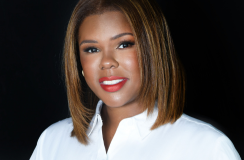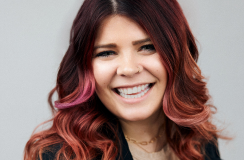arah Romer’s first two jobs involved selling advertising to small business owners, a class of entrepreneurs she came to admire. This exposure planted the seed that one day she would like to be the owner of a local small business herself.
Scrolling through BizBuySell in 2014, Sarah discovered downtown Austin hair salon Bella Salon. The owner, Josh Martin, had been struck with cancer. A hair stylist himself, Josh wanted to continue working “behind the chair” with customers but transfer ownership of the larger salon to someone else.
“The biggest thing I would suggest to someone who's looking to acquire a business would be to include as part of their due diligence an assessment of the team, the people, and the culture. I did not assess that, and that became the biggest challenge for me.”
Bella was Josh’s life’s work. Established in 1995, the salon had been a hugely successful trailblazer in the ‘90s. But as former employees started their own competitors, its glory — and revenue — had faded.
Looking at Bella’s numbers, Sarah didn’t believe it was worth anywhere near the $450,000 Josh was asking. Based on traditional methods of salon valuation, she calculated that a reasonable purchase price would actually be below $100,000.
But not wanting to insult him, she didn’t make such a low counter offer and instead walked away.
Six months later, Josh had unfortunately succumbed to his cancer, and a family friend was running Bella, desperately trying to sell it. Sarah was more comfortable submitting her offer this time, and the salon became hers for $80,000.
Although Sarah had no experience in the hair and beauty industry, she knew she could cut costs and modernize the business. She planned to bring in new customers by promoting Bella as a luxury salon.
However, she didn’t count on how the stylists would feel. They had been setting their own prices and hours, and when Sarah insisted on consistency and more structure, several quit — and took their customers with them.
Sarah also hadn’t counted on just how grueling running a salon could be. Within 18 months of owning the business, she decided she wanted to sell. In 2018 she sold Bella for $475,000.
In this episode, Sarah explains why salons in particular are so tricky to own. She also talks about the importance of knowing the culture of the workplace you’re acquiring, and where salon owners really make their margins.

Check out:
✳️ Top takeaways from the episode
✳️ Episode highlights with timestamps
Acquisition Entrepreneur: Sarah Romer
💵 What she acquired: Sarah worked with small business owners through her jobs at Washingtonian magazine and Groupon, and dreamed of running a local business herself. In 2015, she acquired Bella Salon in downtown Austin for $80,000. Despite turning it around and making it thrive again, she also struggled with low margins, uncooperative stylists, and intense work hours, and decided to sell Bella in 2018 for $475,000. She’s now a strategist at small business consultancy The Ronin Society.
💡 Key quote: “I know my strengths are more on the operations side. I felt very confident in my ability to operate a business. I did not feel confident in my ability to start a business from scratch, and grow it to something that I could then operate. I didn't think that I had any great ideas that someone else hadn't thought of before.”
👋 Where to find her: LinkedIn
Acquisition Tips From the Episode
Top takeaways from this conversation
💼 Franchising vs. acquiring vs. founding
There are three main ways to become the owner of a local small business: start one yourself, become a franchisee of a chain, or acquire an existing business outright. Which of these paths you go down ultimately depends on what you want your day-to-day life at work to look like, and what you’re good at.
Sarah knew that her strengths lay in operations, not creating something from scratch. So she decided against founding a business, and very nearly became a franchisee. But when her attorney explained that franchisees don’t have much control over the services they sell or how they market the brand — “the only thing you're really going to be able to make decisions about is staffing” — she realized that she wanted to have more say over her business.
Given that founding from scratch was out, she decided to go the acquisition route.
😠 Factor in human resistance to change.
When Sarah acquired Bella Salon, she had no experience in hairstyling or beauty.
She believed that her value as the salon’s owner came from her skills in marketing and vision to modernize the business. It quickly became apparent that she had underestimated the importance — and challenge — of getting existing staff on board with new ideas.
Sarah realized that the previous owner’s management approach had been laissez-faire. Stylists who were W2 employees acted like contractors, with the freedom to set their own hours, prices, and approaches to the work. Some appreciated the consistency and structure Sarah brought in, but several quit — right as higher rents kicked in — and took their customers with them.
Sarah says that if she were doing it all again, she would do more due diligence on staff.
“The biggest thing I would suggest to someone who's looking to acquire a business would be to include as part of their due diligence an assessment of the team, the people, and the culture,” she says.
“I did not assess that, and that became the biggest challenge for me.”
🛍️ Build your business on shampoo, not stylists.
If you’re thinking of buying a salon, Sarah recommends building out the retail side.
Sell products, not just haircuts & styling.
The margins are much higher on physical products than on services, and more predictable. Stylists turn over, and when they leave they take their customers with them.
Finally, customers trust their stylists, who are therefore in the perfect position to recommend beauty products sold by the salon.
Episode Highlights
Inflection points from the show
[2:10] Hopping on the SMB bandwagon: Sarah explains how her first job in DC selling advertising for a local lifestyle magazine to small business owners, followed by a similar role with Groupon, got her excited about the ins and outs of small businesses.
[3:50] Closer to the dream: When Sarah and her family moved to Austin in 2012, she realized that her money could go further there than in DC, and that she might be able to buy a business. But for the time being, she took a job with PayPal.
[6:48] Why salons? Sarah had no experience in beauty or haircare. But she chose a retail business over tech — which would have been closer to her background — because she wanted to own a business where she could see the thing they were selling.
[7:42] To franchise or to acquire? When choosing between founding a business or buying an existing one, Sarah evaluated her strengths and decided they lay more in ops than original ideas. Initially, she considered buying a franchise license, but realized (thanks to her attorney) that she wouldn’t have as much control as she’d like over things like strategy and marketing.
[9:50] Salon for sale: In fall 2014, Sarah found Bella Salon on business buying and selling site BizBuySell. The salon was founded in 1995 by its owner Josh Martin. Josh had learned that he had cancer and made the decision to sell Bella but keep doing hair.
[11:45] Effects of aging: Josh was asking for $450,000. Once Sarah looked at the numbers, she felt that the business wasn’t worth that much. Her formula for evaluating a salon’s financial worth was to multiply the profit by two or three. Bella had been hot in the ‘90s, but now faced stiff competition.
[14:57] Owner on board: Unlike some acquisition entrepreneurs, Sarah would have otherwise been happy to have Josh working for the business after she acquired it. She didn’t want to insult him by saying that Bella wasn’t worth nearly as much as he thought, so she didn’t make a counter offer and walked away from the acquisition.
[16:01] Situational shift: Six months later, Josh had sadly passed away, and the business still hadn’t been sold. A family friend was operating Bella and still trying to sell it. Under these new circumstances, Sarah felt more comfortable making her low offer. She bought Bella Salon for $80,000.
[20:29] Making the most of a bargain: Sarah had budgeted $200,000-$300,000 for her business venture, so the lower price tag meant she had money for renovations and operational improvements. Not knowing then that she could finance the acquisition, she paid cash.
[21:49] Decorating montage: Sarah jumped straight in with modernization and cost-saving measures. For example, she updated the salon’s foyer area with a more chic look and fixed obvious overspending issues: the business was paying $600 a month for internet and still had a landline.
[26:47] The human element: With all her planning, Sarah hadn’t taken into account that the staff might not be on board with what seemed to her like obvious improvements. For example, stylists had been charging what they wanted and choosing their own hours. Some of them didn’t appreciate Sarah’s insistence on consistency for the sake of customers. When they left, so did their clients.
[33:46] Breaking even: By the end of Sarah’s first year, Bella Salon was breaking even at $1 million in revenue. But that was based on a lease negotiated 10 years earlier. The higher rents kicked in during 2015, at the same time that some of the stylists left. The business started losing about $10,000 a month. Sarah hired new stylists, and the higher prices helped. Revenue increased to $1.4 million, but still without a lot of profits. That improved in 2017.
[36:25] Breaking down: Sarah says that 2016, the first full year of her ownership, was the hardest year of her life. She was managing the salon seven and then six days a week, and had young children at home. Even with all her hard work, the margins were razor thin.
[38:54] Arrivederci Bella: By the end of 2016, Sarah accepted that Bella Salon wasn’t going to generate enough money to make it worth the intense work she was putting in. She switched her approach to focus on trying to make it a valuable investment for a new owner.
[39:55] Are you the next salon mastermind? Even though Sarah struggled as a salon owner, she says that doesn’t mean someone else couldn’t do well acquiring this type of business. She didn’t have a passion for the industry, but for someone who does, particularly an ambitious stylist, it could be a good way to make more money and build a brand.
[42:05] Looking on the bright side: With hindsight, Sarah is proud of what she did with Bella Salon. She sold it for $475,000 in 2018, nearly six times what she’d paid for it four years earlier. And she earned two awards from the biggest hairstyling trade magazine for best practices in digital marketing and growth. She’d like to acquire an existing business again (but not in retail!).
[48:45] Build your business on shampoo, not stylists: If you’re thinking of buying a salon, Sarah recommends building out the retail side. The margins are much higher on haircare, skincare and makeup than on treatments, and you can’t rely on stylists: when they leave, they take their customers with them. Plus customers trust products recommended by the people taking care of them.






%20-%20thumbnail.png)

.png)




%20-%20thumbnail.png)















%20-%20thumbnail.png)














































































